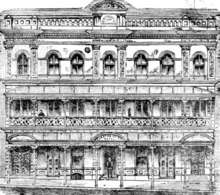Theatre Royal (Brisbane)
The Theatre Royal was the first theatre in Brisbane, Queensland, Australia. It opened in 1865.[1] It was designed by Andrea Strombuco.

History
%2C_1881.jpg)
The Theatre Royal was located at 80 Elizabeth Street, Brisbane. It was the first official theatre in Brisbane, with its first version opening in 1865.[2] The newly modelled Theatre Royal opened 18 April 1881. It was again remodelled in 1911 when electric lights were installed.
In 1940 it was again renovated and the theatre was occupied by U.S. Army from 1942 to 1945. A small number of revues for American servicemen were offered during this time. It resumed its life as a theatre following the war.
From 1949-1959, comedian George Wallace Junior presented weekly variety shows at the Theatre Royal.[3] Early shows featured an all male, ex-army revue company called the Kangaroos. A ballet and showgirls were eventually added to the show to broaden its audience appeal. The female performers began to be called the “Royal Showgirls” and were dressed in bikinis, mini-skirts and shorts. The shows were vaudeville or burlesque in style and featured titles which implied nudity. The shows attracted a wide cross section of the Brisbane population to what was described as the ‘Brisbane Folies Bergere’.
Following the introduction of television to Brisbane in 1957, Wallace transferred his variety show to a TV format and attendance at the Theatre Royal shows began to decline. Nudity was promoted to improve audience numbers but by 1959 the theatre was compelled to close. The Queensland Symphony Orchestra and Queensland Theatre Company later used it. It was operated as a nightclub, Swizzles[4] in the 1980’s before being demolished in 1987 to make way for the Myer Centre complex development in 1987.
Interior
The theatre could seat 1,350 people, with 350 in the dress circle, 250 in the stalls and 750 in the pit. It was designed by Andrea Strombuco who had also designed Her Majesty’s Theatre. It had a private refreshment room for the dress circle patrons and a smoking room.[1]
Decoration
Its proscenium had gold Corinthian columns. The horse shoe shape of the dress circle obscured side views of the stage. After the 1911 refurbishment, the interior was marked by salmon pink, green and cream accents. Seating and ventilation was improved along with the installation of a sliding roof.[1]
Legacy
Programs from the Theatre Royal are held in the State Library of Queensland and Queensland Performing Arts Centre Museum. Selected programs are also held in the University of Queensland Fryer Library.[5]
References
| Wikimedia Commons has media related to Theatre Royal (Brisbane). |
- "Theatre Royal". resource.acu.edu.au. Archived from the original on 27 February 2020. Retrieved 1 November 2019.
- "TELEGRAPHIC". Brisbane Courier (Qld. : 1864 - 1933). 26 May 1865. p. 2. Retrieved 1 November 2019.
- Bollen, Jonathan (3 April 2011). "Theatre Royal, Brisbane". Research on performance and desire. Archived from the original on 1 November 2019. Retrieved 1 November 2019.
- "Club List | Clubbed Out". Archived from the original on 3 November 2019. Retrieved 1 November 2019.
- "Theatre Royal (Brisbane) Theatre Program File - Fryer Manuscripts". manuscripts.library.uq.edu.au. Archived from the original on 1 November 2019. Retrieved 1 November 2019.